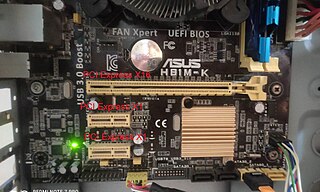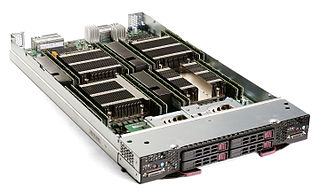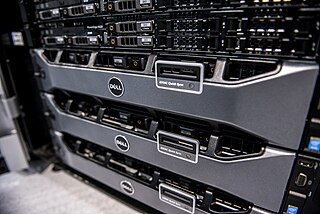
PCI Express, officially abbreviated as PCIe or PCI-e, is a high-speed serial computer expansion bus standard, designed to replace the older PCI, PCI-X and AGP bus standards. It is the common motherboard interface for personal computers' graphics cards, capture cards, sound cards, hard disk drive host adapters, SSDs, Wi-Fi, and Ethernet hardware connections. PCIe has numerous improvements over the older standards, including higher maximum system bus throughput, lower I/O pin count and smaller physical footprint, better performance scaling for bus devices, a more detailed error detection and reporting mechanism, and native hot-swap functionality. More recent revisions of the PCIe standard provide hardware support for I/O virtualization.

A blade server is a stripped-down server computer with a modular design optimized to minimize the use of physical space and energy. Blade servers have many components removed to save space, minimize power consumption and other considerations, while still having all the functional components to be considered a computer. Unlike a rack-mount server, a blade server fits inside a blade enclosure, which can hold multiple blade servers, providing services such as power, cooling, networking, various interconnects and management. Together, blades and the blade enclosure form a blade system, which may itself be rack-mounted. Different blade providers have differing principles regarding what to include in the blade itself, and in the blade system as a whole.
Platform virtualization software, specifically emulators and hypervisors, are software packages that emulate the whole physical computer machine, often providing multiple virtual machines on one physical platform. The table below compares basic information about platform virtualization hypervisors.
The Dell Remote Access Controller (DRAC) is an out-of-band management platform on certain Dell servers. The platform may be provided on a separate expansion card, or integrated into the main board; when integrated, the platform is referred to as iDRAC.

The PowerEdge (PE) line is Dell's server computer product line. PowerEdge machines come configured as tower, rack-mounted, or blade servers. Dell uses a consistent chip-set across servers in the same generation regardless of packaging, allowing for a common set of drivers and system-images.

The IBM BladeCenter was IBM's blade server architecture, until it was replaced by Flex System in 2012. The x86 division was later sold to Lenovo in 2014.
The IBM Remote Supervisor Adapter is a full-length ISA or PCI adapter produced by the IBM corporation.
The AMD 700 chipset series is a set of chipsets designed by ATI for AMD Phenom processors to be sold under the AMD brand. Several members were launched in the end of 2007 and the first half of 2008, others launched throughout the rest of 2008.

VMware ESXi is an enterprise-class, type-1 hypervisor developed by VMware, a subsidiary of Broadcom, for deploying and serving virtual computers. As a type-1 hypervisor, ESXi is not a software application that is installed on an operating system (OS); instead, it includes and integrates vital OS components, such as a kernel.
The AMD 800 chipset series is a set of chipsets developed by AMD, released in 2009. The chipset series was revealed in its presentation slides during the AMD Financial Analyst Day 2007 held on December 13, 2007. This chipset series also marks the return of AMD to the workstation/server market after the completion of the ATI acquisition in October 2006 with the first server chipsets.
The Cisco Nexus series switches are modular and fixed port network switches designed for the data center. Cisco Systems introduced the Nexus Series of switches on January 28, 2008. The first chassis in the Nexus 7000 family is a 10-slot chassis with two supervisor engine slots and eight I/O module slots at the front, as well as five crossbar switch fabric modules at the rear. Beside the Nexus 7000 there are also other models in the Nexus range.
The Dell Inspiron Mini Series is a line of subnotebook/netbook computers designed by Dell. The series was introduced in September 2008 amidst the growing popularity of low-cost netbook computers introduced by competitors.
EqualLogic, Inc. was an American computer data storage company based in Nashua, New Hampshire, active from 2001 to 2007. In 2008, the company was merged into Dell Inc. Dell-branded EqualLogic products are iSCSI-based storage area network (SAN) systems. Dell has 3 different lines of SAN products: EqualLogic, Compellent and Dell PowerVault.
Cisco Unified Computing System (UCS) is a data center server computer product line composed of server hardware, virtualization support, switching fabric, and management software, introduced in 2009 by Cisco Systems. The products are marketed for scalability by integrating many components of a data center that can be managed as a single unit.

The Dell blade server products are built around their M1000e enclosure that can hold their server blades, an embedded EqualLogic iSCSI storage area network and I/O modules including Ethernet, Fibre Channel and InfiniBand switches.
Dell Networking is the name for the networking portfolio of Dell. In the first half of 2013, Dell started to rebrand their different existing networking product brands to Dell Networking. Dell Networking is the name for the networking equipment that was known as Dell PowerConnect, as well as the Force10 portfolio.

Dell Technologies PowerFlex, is a commercial software-defined storage product from Dell Technologies that creates a server-based storage area network (SAN) from local server storage using x86 servers. It converts this direct-attached storage into shared block storage that runs over an IP-based network.
A Dell PowerEdge RAID Controller, or Dell PERC, is a series of RAID, disk array controllers made by Dell for its PowerEdge server computers. The controllers support SAS and SATA hard disk drives (HDDs) and solid-state drives (SSDs).
Harvester is a cloud native hyper-converged infrastructure (HCI) open source software. Harvester was announced in 2020 by SUSE.






